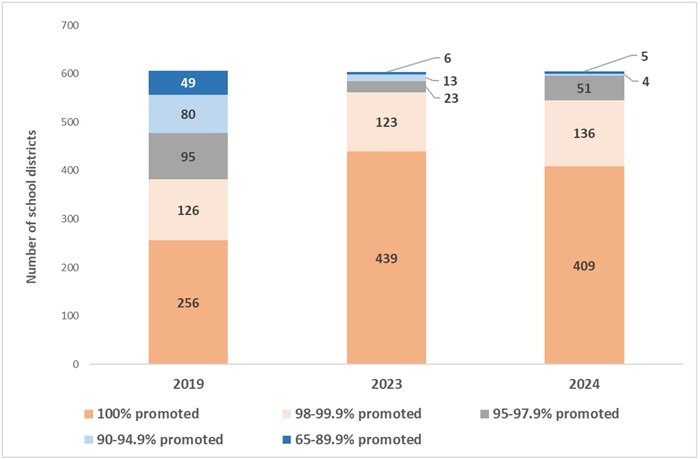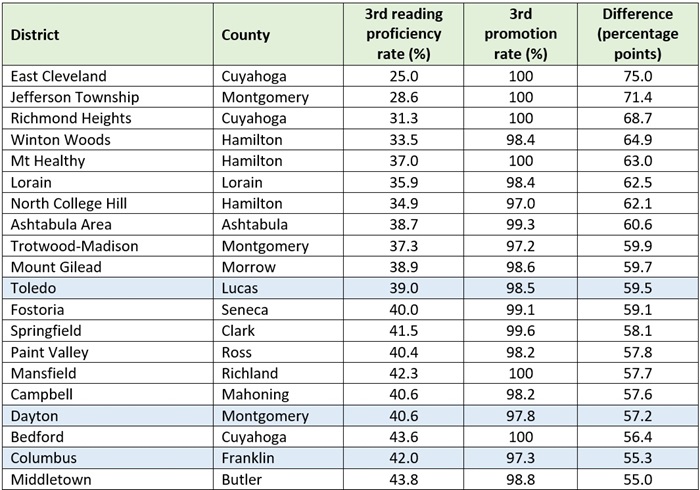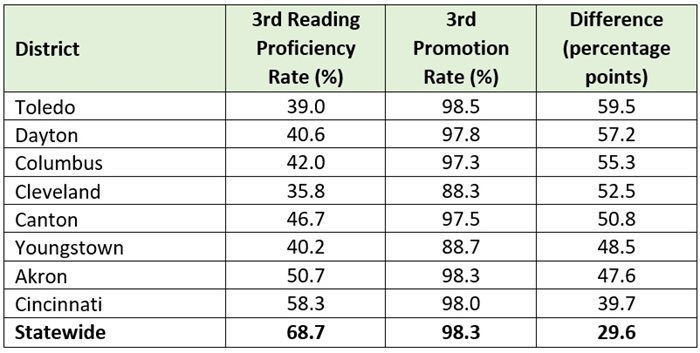Under pressure from public school groups, Ohio lawmakers last year gutted retention requirements that had been in place under the Third Grade Reading Guarantee. This was a setback in Ohio’s otherwise praiseworthy early literacy efforts, as retention—via the extra time and support it provides—has proven to benefit children struggling to acquire basic reading skills. Without a requirement, schools tend to resort to “social promotion,” a discredited practice that advances students to the next grade despite being unprepared for the work they’ll be asked to do.
The legislature did not outright scrap reading retention, but eviscerated it by adding a massive loophole. Under the new policy, schools may promote third graders with reading deficiencies if parents approve. We at Fordham expressed concerns that this would amount to little more than a checkbox exercise that largely entails collecting signatures from parents. The net effect would be the same as a retention-free policy, with overwhelming majorities of third graders being promoted to fourth grade.
The new policy went into effect starting in the 2023–24 school year. The results are, sad to say, as predicted. Across Ohio, virtually every third grader—regardless of reading skill—was promoted to fourth grade. Statewide, an astonishing 98.3 percent of third graders were promoted, and a large majority of districts reported universal third grade promotion rates.
Figure 1 shows that 409 out of 605 Ohio districts promoted 100 percent of third graders last year, while another 187 districts reported rates above 95 percent. Just nine districts reported rates below that mark, with Garfield Heights promoting the lowest percentage at 82 percent. This chart also shows the impact of rolling back the retention mandate. Grade promotion was significantly lower in 2018–19, the last year Ohio enforced third-grade reading retention. Results from the past two years,[1] however, show that social promotion returned en masse in the absence of a clear retention requirement.
Figure 1: Number of school districts by third-grade promotion rate, selected years

Of course, universal promotion would be perfectly acceptable if third graders were achieving reading proficiency across the board. But that’s not happening in most places. Table 1 displays fifteen districts with the largest discrepancies in their third-grade promotion versus proficiency rates. The largest gap is found in East Cleveland, where just 25 percent of third graders achieved reading proficiency last year, but 100 percent (!) were promoted to fourth grade. Jefferson Township near Dayton and Richmond Heights near Cleveland also promoted 100 percent of third graders, despite less than one-third demonstrating proficiency. Three of the Ohio Eight big-city districts—Toledo, Dayton, and Columbus—also appear on this list. All three promoted more than 97 percent of third graders, even though just two in five achieved reading proficiency.
Table 1: Districts with the largest gap in third-grade promotion versus proficiency rates, 2023–24

The next table takes a closer look at all of the Ohio Eight districts’ promotion and proficiency rates, ordered by the size of their gap. Alongside the trio of districts mentioned above, Canton, Akron, and Cincinnati also promoted nearly all third graders (more than 97 percent), despite posting proficiency rates between 47 and 58 percent. Meanwhile, Cleveland and Youngstown promoted 88 and 89 percent of third graders, two of the lowest rates in the state. To their credit, they put the brakes on advancing a relatively large handful of third graders, but still—given their low reading proficiency rates—this is nowhere near the number of students who need the extra time and support.
Table 2: Ohio Eight districts’ third-grade promotion versus proficiency rates, 2023–24

The reluctance of state policymakers and schools to retain students who need more help is deeply troubling. Children across Ohio, including places such as East Cleveland, Columbus, and Dayton, all need a strong reading foundation to tackle the more complex and challenging materials that come in middle and high school. Unfortunately, without a retention mandate, there is no longer a clear-cut assurance—a true “guarantee”—that they will receive the time and supports to become strong readers. When no one stops to intervene, research finds that students become frustrated and many of them decide school isn’t worth it and drop out.
Ohio can’t turn a blind eye to reading deficiencies and social promotion. To be sure, the state is taking positive steps forward in moving schools toward evidence-based instruction known as the science of reading. If implemented well, this effort should increase reading achievement and reduce the need for interventions over the long haul. But after yet another year of system-wide social promotion and too many students falling short of reading proficiency, it’s time for Ohio policymakers to reinstate the third grade retention requirement.
[1] Lawmakers effectively suspended the retention requirement for 2022–23.




